The microwave cable assemblies market is projected to grow substantially from USD 2,579.6 million in 2025 to USD 18,997.9 million by 2035, representing a robust CAGR of 22.1%. This translates to a total growth of USD 16,418.3 million over the decade, driven by strong adoption in telecom, aerospace, defense, and 5G infrastructure. The growth rate reflects the increasing reliance on high-frequency, high-performance cable assemblies for advanced communications and radar systems. The market’s expansion is supported by technological innovation, growing deployment of next-generation wireless networks, and rising demand for compact, efficient, and high-bandwidth solutions.
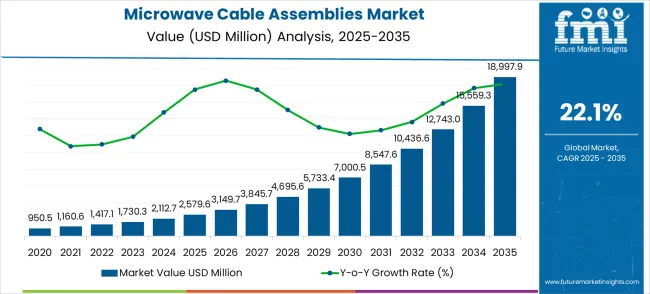
From a ratio perspective, the initial years (2025–2027) account for a moderate share of total growth. The market is projected to grow from USD 2,579.6 million in 2025 to USD 3,845.7 million in 2027, representing an increase of USD 1,266.1 million. This period accounts for approximately 7.7% of the cumulative decade's growth, reflecting early-stage adoption and infrastructure expansion. Growth is driven largely by telecom upgrades and the early adoption of 5G base stations, with North America and the Asia-Pacific region as the dominant contributors. Segment-wise, the telecom and data communication segment likely accounts for the largest share due to demand for reliable microwave links.
| Metric | Value |
|---|---|
| Market Value (2025) | USD 2,579.6 million |
| Market Forecast Value (2035) | USD 18,997.9 million |
| Forecast CAGR (2025-2035) | 22.1% |
Between 2028 and 2031, the market accelerates sharply, expanding from USD 4,695.6 million to USD 10,436.6 million. This five-year period contributes USD 5,741.0 million, nearly 35% of total decade growth. Such acceleration is supported by large-scale rollouts of 5G and emerging 6G networks, where microwave cable assemblies are critical for high-frequency connectivity. Aerospace and defense segments also contribute significantly, driven by advancements in radar systems, satellite communication, and unmanned aerial systems. Technological progress such as miniaturized connectors and enhanced signal integrity contributes strongly to growth during this period.
From 2032 to 2035, growth intensifies further, with the market rising from USD 12,743.0 million to USD 18,997.9 million, adding USD 6,254.9 million. This final phase contributes over 38% of total growth, making it the highest-growth period in proportion terms. This is fueled by full-scale adoption of next-generation wireless infrastructure globally, expansion of defense communication systems, and increasing integration of microwave assemblies in autonomous systems. Ratio analysis confirms that later years dominate growth contribution due to compounding annual increases. The market’s trajectory suggests a strong exponential growth trend, with 2033–2035 marking a significant inflection point driven by accelerated deployment and technological innovation.
The market grows by enabling telecommunications companies and system integrators to optimize signal transmission performance while accessing advanced connectivity technologies without the need for substantial infrastructure complexity. Communications infrastructure providers and electronics manufacturers face mounting pressure to enhance network performance and improve signal integrity, with microwave cable assembly systems typically requiring 40-60% less signal loss than traditional connectivity alternatives, making specialized assemblies essential for competitive telecommunications deployment. The telecommunications industry's need for reliable high-frequency connectivity and application-specific signal transmission creates demand for comprehensive cable assembly solutions that can provide superior electrical performance, maintain installation flexibility, and ensure consistent connectivity without long-term signal degradation concerns.
Government initiatives promoting 5G infrastructure development and advanced communication technologies drive adoption in telecommunications, defense, and automotive applications, where reliable signal transmission has a direct impact on system performance and operational efficiency. The manufacturing complexity constraints during peak demand periods and the technical expertise requirements for advanced assembly production may limit service accessibility among smaller manufacturers and developing regions with limited high-frequency manufacturing infrastructure.
The microwave cable assemblies market represents an explosive growth opportunity, expanding from USD 2.58 billion in 2025 to USD 19.0 billion by 2035 at an exceptional 22.1% CAGR. As global telecommunications infrastructure undergoes massive transformation through 5G deployment, satellite communication expansion, and defense system modernization, microwave cable assemblies have evolved from niche connectivity components to critical enablers of high-frequency signal transmission across communications networks, military systems, and automotive electronics requiring superior signal integrity and minimal loss characteristics.
The convergence of 5G network rollouts accelerating globally, satellite communication system expansion, defense modernization programs, and autonomous vehicle technology development creates unprecedented demand momentum. Advanced flexible assemblies offering superior bend radius capabilities, high-performance semi-rigid solutions delivering maximum signal integrity, and specialized millimeter-wave technologies will capture premium positioning, while geographic expansion into high-growth Asian markets and emerging application penetration will drive volume leadership. Government infrastructure investments and telecommunications modernization mandates provide structural support.
The market is segmented by product type, application, and region. By product type, the market is divided into flexible cable assemblies, semi-flexible cable assemblies, semi-rigid cable assemblies, and others. Based on the application, the market is categorized into communications infrastructure, military and defense, and automotive electronics. Regionally, the market is divided into Asia Pacific, Europe, North America, Latin America, and the Middle East & Africa.
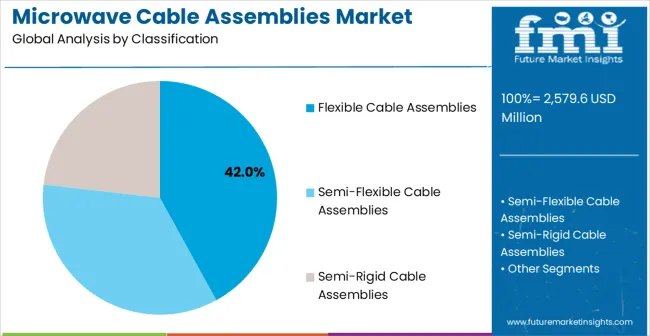
The flexible cable assemblies segment represents the dominant force in the market, capturing approximately 42.0% of total market share in 2025. This advanced product category encompasses assemblies featuring sophisticated bend radius capabilities and installation convenience, including high-performance flexible designs and advanced routing technologies that enable superior connectivity performance and installation versatility across all operational conditions. The flexible cable assemblies segment's market leadership stems from its superior installation capabilities, with assemblies capable of handling diverse routing applications while maintaining consistent electrical performance standards and mechanical reliability across all installation environments.
The semi-flexible cable assemblies segment maintains a substantial 28.5% market share, serving customers who require reliable connectivity performance with enhanced mechanical stability features. These systems offer balanced solutions for medium-complexity installations while providing sufficient flexibility capabilities to meet regional telecommunications and defense demands. The semi-rigid cable assemblies segment accounts for approximately 18.2% market share, focusing on applications requiring maximum signal integrity and minimal loss characteristics. The remaining market segments, categorized as specialty or hybrid systems, account for approximately 11.3% of the market, serving niche applications requiring specific assembly configurations or specialized performance parameters.
Key technological advantages driving the flexible cable assemblies segment include:
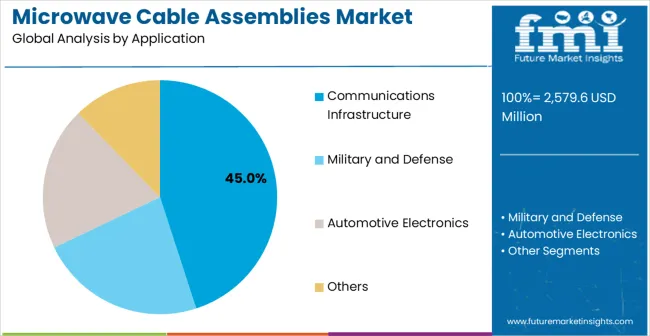
Communications infrastructure applications dominate the market with approximately 45.0% market share in 2025, reflecting the critical role of cable assemblies in supporting global telecommunications infrastructure development and network deployment worldwide. The communications infrastructure segment's market leadership is reinforced by increasing 5G deployment trends, network modernization investments, and rising demand for high-frequency connectivity solutions in telecommunications and data transmission projects across developed and emerging markets.
The military and defense segment represents the second-largest application category, capturing 32.4% market share through specialized assembly requirements for defense communications, radar systems, and aerospace applications. This segment benefits from growing demand for high-reliability, mission-critical assemblies that meet specific performance requirements, environmental compliance standards, and security protocols in challenging operational environments.
The automotive electronics segment accounts for 22.6% market share, serving vehicle communication systems, radar applications, and advanced driver assistance systems across multiple automotive sectors.
Key market dynamics supporting application growth include:
The market is driven by three concrete demand factors tied to telecommunications infrastructure outcomes. First, 5G network deployment and telecommunications infrastructure expansion create increasing demand for high-frequency connectivity systems, with communications infrastructure requirements expanding by 25-30% annually in major developing countries worldwide, requiring comprehensive cable assembly infrastructure. Second, government initiatives promoting advanced telecommunications and defense communication modernization drive increased adoption of specialized assembly solutions, with many countries allocating significant resources toward infrastructure development by 2030. Third, technological advancements in high-frequency technologies and signal integrity enable more reliable and cost-effective connectivity solutions that reduce transmission losses while improving system performance and installation standards.
Market restraints include high manufacturing investment requirements for precision assembly production that can deter new market entrants from developing comprehensive connectivity capabilities, particularly in developing regions where funding for advanced manufacturing equipment remains limited. Technical complexity constraints during peak deployment periods pose another significant challenge, as specialized requirements can create production bottlenecks and project delays, potentially causing increased costs and timeline extensions. Quality control complexity and testing expertise requirements across different frequency ranges create additional operational challenges for assembly providers, demanding ongoing investment in testing capabilities and technical infrastructure.
Key trends indicate accelerated adoption in Asia-Pacific markets, particularly China and India, where rapid telecommunications deployment and infrastructure development drive comprehensive microwave cable assembly system expansion. Technology integration trends toward advanced connector systems with precision manufacturing, high-frequency capabilities, and integrated testing solutions enable proactive quality approaches that reduce signal degradation and operational costs. The market thesis could face disruption if alternative connectivity methods or significant changes in telecommunications approaches minimize reliance on traditional microwave cable assembly solutions.
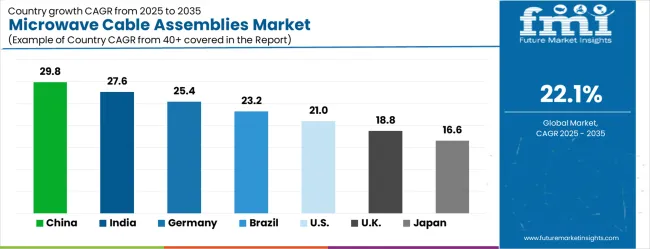
| Country | CAGR (2025-2035) |
|---|---|
| China | 29.8% |
| India | 27.6% |
| Germany | 25.4% |
| Brazil | 23.2% |
| USA | 21.0% |
| UK | 18.8% |
| Japan | 16.6% |
The market is gaining momentum worldwide, with China taking the lead thanks to massive telecommunications infrastructure expansion and government-backed 5G network deployment programs. Close behind, India benefits from expanding digital infrastructure activities and telecommunications modernization initiatives, positioning itself as a strategic growth hub in the Asia-Pacific region. Germany shows steady advancement, where integration of advanced manufacturing technologies strengthens its role in the European telecommunications supply chain. Brazil is focusing on telecommunications infrastructure expansion and industrial electronics development, signaling an ambition to capitalize on the growing opportunities in South American communications markets. The USA stands out for its advanced technology adoption in existing defense and aerospace operations, and the UK and Japan continue to record consistent progress in telecommunications modernization. Together, China and India anchor the global expansion story, while the rest build stability and diversity into the market's growth path.
The report covers an in-depth analysis of 40+ countries; top-performing countries are highlighted below.
China demonstrates the strongest growth potential in the Microwave Cable Assemblies Market with a CAGR of 29.8% through 2035. The country's leadership position stems from massive telecommunications infrastructure development projects, government-backed 5G network deployment programs, and stringent performance regulations driving the adoption of advanced cable assembly solutions. Growth is concentrated in major metropolitan areas, including Beijing, Shanghai, Guangzhou, and Shenzhen, where telecommunications projects and network infrastructure are implementing advanced microwave cable assembly solutions for enhanced signal transmission and system reliability. Distribution channels through state-owned telecommunications enterprises and government-approved contractors expand deployment across infrastructure projects and network development initiatives. The country's Digital China strategy provides policy support for telecommunications modernization, including advanced cable assembly system adoption.
Key market factors:
In Mumbai, Delhi, Bangalore, and Chennai, the adoption of comprehensive microwave cable assembly solutions is accelerating across telecommunications projects and digital infrastructure development initiatives, driven by rapid digitalization and government connectivity programs. The market demonstrates strong growth momentum with a CAGR of 27.6% through 2035, linked to comprehensive telecommunications development and increasing focus on high-speed communication solutions. Indian telecommunications companies are implementing advanced cable assembly systems and connectivity platforms to enhance network performance while meeting growing demand in expanding urban development and industrial sectors. The country's Digital India initiative creates constant demand for microwave cable assembly solutions, while increasing focus on network efficiency drives adoption of advanced connectivity management systems.
Germany's advanced telecommunications sector demonstrates sophisticated implementation of microwave cable assembly solutions, with documented case studies showing 35% signal integrity improvement in network operations through intelligent connectivity management platforms. The country's telecommunications infrastructure in major industrial centers, including Munich, Berlin, Hamburg, and Frankfurt, showcases integration of advanced cable assembly technologies with existing network systems, leveraging expertise in precision manufacturing and telecommunications technologies. German telecommunications companies prioritize quality and reliability standards, creating demand for high-performance cable assembly solutions that support continuous improvement initiatives and network optimization requirements. The market maintains steady growth through focus on Industry 4.0 integration and performance compliance, with a CAGR of 25.4% through 2035.
Key development areas:
Brazil's market expansion is driven by diverse telecommunications demand, including network infrastructure in São Paulo and Rio de Janeiro, digital connectivity projects in Brasília and other major cities, and comprehensive telecommunications modernization across multiple states. The country demonstrates promising growth potential with a CAGR of 23.2% through 2035, supported by federal government infrastructure investment programs and state-level telecommunications development initiatives. Brazilian telecommunications companies face implementation challenges related to technology financing constraints and technical expertise availability, requiring phased deployment approaches and support from international suppliers. The growing connectivity demands and network efficiency requirements create compelling business cases for microwave cable assembly adoption, particularly in urban areas where signal quality has a direct impact on service competitiveness.
Market characteristics:
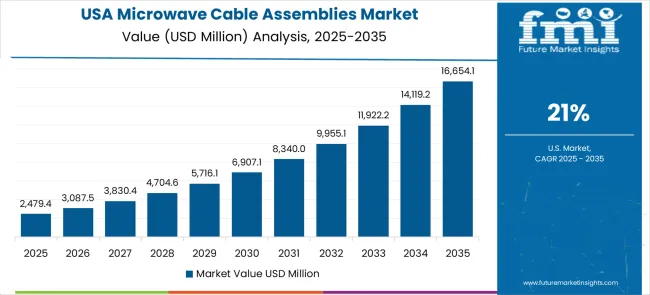
The USA market leads in advanced microwave cable assembly innovation based on integration with intelligent communication systems and defense technologies for enhanced operational performance. The country shows strong potential with a CAGR of 21.0% through 2035, driven by the modernization of existing telecommunications infrastructure and the expansion of technology-enabled defense facilities in major metropolitan areas, including California, Texas, Florida, and Virginia. American companies are adopting intelligent cable assembly systems for performance improvement and mission-critical compliance, particularly in regions with advanced defense requirements and aerospace applications demanding comprehensive connectivity upgrades. Technology deployment channels through established defense contractors and telecommunications providers expand coverage across communication facilities and system operators.
Leading market segments:
In London, Manchester, Birmingham, and Glasgow, telecommunications facilities are implementing comprehensive microwave cable assembly solutions to modernize existing network infrastructure and improve signal quality, with documented case studies showing a 28% reduction in signal loss through advanced assembly systems. The market shows moderate growth potential with a CAGR of 18.8% through 2035, linked to the ongoing modernization of telecommunications facilities, network infrastructure, and emerging satellite communication projects in major cities. British telecommunications companies are adopting intelligent assembly and monitoring platforms to enhance connectivity reliability while maintaining performance standards demanded by commercial and government sectors. The country's established telecommunications infrastructure creates steady demand for assembly upgrade and modernization solutions that integrate with existing network systems.
Market development factors:
Japan's market demonstrates sophisticated implementation focused on precision manufacturing and operational excellence optimization, with documented integration of advanced connectivity systems, achieving 30% improvement in signal performance across telecommunications and defense facilities. The country maintains steady growth momentum with a CAGR of 16.6% through 2035, driven by telecommunications facilities' focus on quality standards and continuous improvement methodologies that align with lean manufacturing principles applied to network operations. Major metropolitan areas, including Tokyo, Osaka, Nagoya, and Fukuoka, showcase advanced deployment of intelligent assembly platforms where connectivity systems integrate seamlessly with existing network control systems and comprehensive quality management programs.
Key market characteristics:
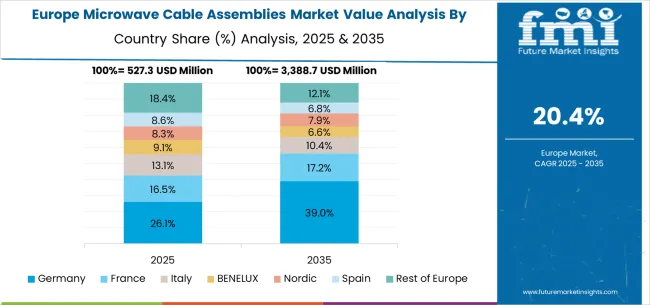
The microwave cable assemblies market in Europe is projected to grow from USD 516.2 million in 2025 to USD 3,799.6 million by 2035, registering a CAGR of 22.1% over the forecast period. Germany is expected to maintain its leadership position with a 35.2% market share in 2025, declining slightly to 34.8% by 2035, supported by its strong automotive electronics industry, advanced manufacturing facilities, and comprehensive telecommunications equipment supply network serving major European markets.
France follows with an 18.5% share in 2025, projected to reach 18.8% by 2035, driven by robust demand for microwave cable assemblies in aerospace applications, satellite communication systems, and defense electronics infrastructure. The United Kingdom holds a 16.2% share in 2025, expected to decrease to 15.9% by 2035, supported by strong telecommunications modernization demand but facing challenges from supply chain adjustments.
Italy commands a 12.1% share in 2025, projected to reach 12.3% by 2035, while Spain accounts for 8.4% in 2025, expected to reach 8.6% by 2035. The Netherlands maintains a 4.2% share in 2025, growing to 4.3% by 2035. The Rest of Europe region is anticipated to retain its collective share at 5.3% by 2035, attributed to increasing telecommunications infrastructure adoption in Nordic countries and emerging Eastern European network facilities implementing modernization programs.
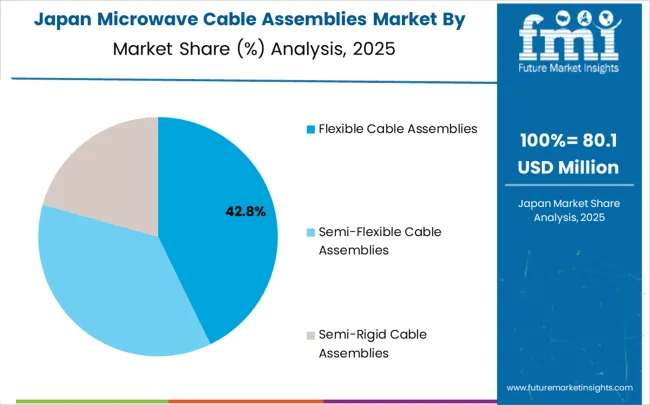
The Japanese market demonstrates a mature and precision-focused landscape, characterized by sophisticated integration of flexible cable assembly systems with existing telecommunications infrastructure across network facilities, equipment supply networks, and automated production lines. Japan's focus on operational excellence and quality standards drives demand for high-reliability cable assembly solutions that support kaizen continuous improvement initiatives and statistical process control requirements in telecommunications operations.
The market benefits from strong partnerships between international connectivity providers like Rosenberger, TE Connectivity, and domestic technology leaders, including Murata, Hirose, and Japan Aviation Electronics, creating comprehensive service ecosystems that prioritize assembly reliability and technical training programs. Network centers in Tokyo, Osaka, Nagoya, and other major metropolitan areas showcase advanced quality implementations where cable assembly systems achieve 98% reliability through integrated monitoring programs.
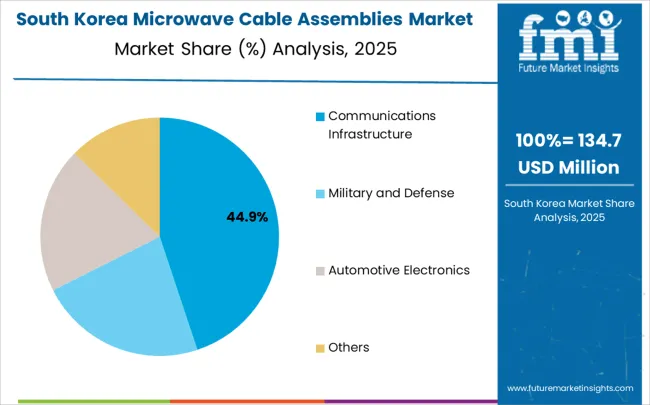
The South Korean market is characterized by strong international technology provider presence, with companies like Rosenberger, TE Connectivity, and Amphenol maintaining dominant positions through comprehensive system integration and technical services capabilities for telecommunications facilities and network infrastructure applications. The market is demonstrating a growing focus on localized technical support and rapid deployment capabilities, as Korean telecommunications companies increasingly demand customized solutions that integrate with domestic network infrastructure and advanced system control technologies deployed across the Seoul Metropolitan Area and other major industrial cities.
Local electronics companies and regional service integrators are gaining market share through strategic partnerships with global providers, offering specialized services including technical training programs and certification services for assembly specialists. The competitive landscape shows increasing collaboration between multinational connectivity companies and Korean technology specialists, creating hybrid service models that combine international engineering expertise with local market knowledge and customer relationship management.
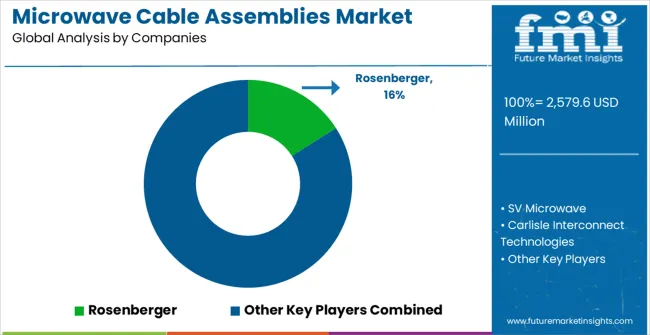
The market features approximately 30-40 meaningful players with moderate concentration, where the top three companies control roughly 35-42% of global market share through established connectivity portfolios and extensive telecommunications industry relationships. Competition centers on signal integrity, technical capabilities, and manufacturing precision rather than price competition alone.
Market leaders include Rosenberger, SV Microwave, and Carlisle Interconnect Technologies, which maintain competitive advantages through comprehensive cable assembly solution portfolios, global service networks, and deep expertise in the telecommunications and defense sectors, creating high switching costs for customers. These companies leverage established technical relationships and ongoing service contracts to defend market positions while expanding into adjacent telecommunications and defense applications.
Challengers encompass TE Connectivity and Amphenol, which compete through specialized connectivity solutions and strong regional presence in key telecommunications markets. Technology specialists, including Huber+Suhner, JST, and Murata, focus on specific assembly technologies or vertical applications, offering differentiated capabilities in high-frequency connectivity, precision manufacturing, and application-specific solutions.
Regional players and emerging connectivity providers create competitive pressure through cost-effective solutions and rapid deployment capabilities, particularly in high-growth markets including China and India, where local presence provides advantages in customer support and regulatory compliance. Market dynamics favor companies that combine advanced cable assembly technologies with comprehensive technical services that address the complete connectivity lifecycle from design through ongoing performance optimization and system support.
| Item | Value |
|---|---|
| Quantitative Units | USD 2,579.6 million |
| Product Type | Flexible Cable Assemblies, Semi-Flexible Cable Assemblies, Semi-Rigid Cable Assemblies, Others |
| Application | Communications Infrastructure, Military and Defense, Automotive Electronics |
| Regions Covered | Asia Pacific, Europe, North America, Latin America, Middle East & Africa |
| Country Covered | China, India, Germany, Brazil, the USA, the UK, Japan, and 40+ countries |
| Key Companies Profiled | Rosenberger, SV Microwave, Carlisle Interconnect Technologies, TE Connectivity, Amphenol, Huber+Suhner, JST, Murata, Hirose, Dai-ichi Seiko, Japan Aviation Electronics, Times Microwave Systems, Pasternack, Molex, Junkosha |
| Additional Attributes | Dollar sales by product type and application categories, regional adoption trends across Asia Pacific, Europe, and North America, competitive landscape with assembly providers and technology integrators, telecommunications infrastructure requirements and specifications, integration with 5G networks and satellite communication platforms, innovations in cable assembly technology and connector systems, and development of specialized applications with signal integrity and performance capabilities. |
The global microwave cable assemblies market is estimated to be valued at USD 2,579.6 million in 2025.
The market size for the microwave cable assemblies market is projected to reach USD 18,997.9 million by 2035.
The microwave cable assemblies market is expected to grow at a 22.1% CAGR between 2025 and 2035.
The key product types in microwave cable assemblies market are flexible cable assemblies, semi-flexible cable assemblies and semi-rigid cable assemblies.
In terms of application, communications infrastructure segment to command 45.0% share in the microwave cable assemblies market in 2025.






Our Research Products

The "Full Research Suite" delivers actionable market intel, deep dives on markets or technologies, so clients act faster, cut risk, and unlock growth.

The Leaderboard benchmarks and ranks top vendors, classifying them as Established Leaders, Leading Challengers, or Disruptors & Challengers.

Locates where complements amplify value and substitutes erode it, forecasting net impact by horizon

We deliver granular, decision-grade intel: market sizing, 5-year forecasts, pricing, adoption, usage, revenue, and operational KPIs—plus competitor tracking, regulation, and value chains—across 60 countries broadly.

Spot the shifts before they hit your P&L. We track inflection points, adoption curves, pricing moves, and ecosystem plays to show where demand is heading, why it is changing, and what to do next across high-growth markets and disruptive tech

Real-time reads of user behavior. We track shifting priorities, perceptions of today’s and next-gen services, and provider experience, then pace how fast tech moves from trial to adoption, blending buyer, consumer, and channel inputs with social signals (#WhySwitch, #UX).

Partner with our analyst team to build a custom report designed around your business priorities. From analysing market trends to assessing competitors or crafting bespoke datasets, we tailor insights to your needs.
Supplier Intelligence
Discovery & Profiling
Capacity & Footprint
Performance & Risk
Compliance & Governance
Commercial Readiness
Who Supplies Whom
Scorecards & Shortlists
Playbooks & Docs
Category Intelligence
Definition & Scope
Demand & Use Cases
Cost Drivers
Market Structure
Supply Chain Map
Trade & Policy
Operating Norms
Deliverables
Buyer Intelligence
Account Basics
Spend & Scope
Procurement Model
Vendor Requirements
Terms & Policies
Entry Strategy
Pain Points & Triggers
Outputs
Pricing Analysis
Benchmarks
Trends
Should-Cost
Indexation
Landed Cost
Commercial Terms
Deliverables
Brand Analysis
Positioning & Value Prop
Share & Presence
Customer Evidence
Go-to-Market
Digital & Reputation
Compliance & Trust
KPIs & Gaps
Outputs
Full Research Suite comprises of:
Market outlook & trends analysis
Interviews & case studies
Strategic recommendations
Vendor profiles & capabilities analysis
5-year forecasts
8 regions and 60+ country-level data splits
Market segment data splits
12 months of continuous data updates
DELIVERED AS:
PDF EXCEL ONLINE
Microwave Source Market Size and Share Forecast Outlook 2025 to 2035
Microwave Monolithic Integrated Circuits Market Size and Share Forecast Outlook 2025 to 2035
Microwave Oven Market Size and Share Forecast Outlook 2025 to 2035
Microwaveable Stuffed Animal Toys Market Size and Share Forecast Outlook 2025 to 2035
Microwave Ablation Devices Market Size and Share Forecast Outlook 2025 to 2035
Microwave Market Size and Share Forecast Outlook 2025 to 2035
Microwave Backhaul System Market Size and Share Forecast Outlook 2025 to 2035
Microwave Device Market Size and Share Forecast Outlook 2025 to 2035
Microwave-Safe Utensils Market Size and Share Forecast Outlook 2025 to 2035
Microwave Absorbing Material Market Size, Growth, and Forecast 2025 to 2035
Microwave Power Meter Market
Microwave Antenna Market
High-Power Microwave Source Market Size and Share Forecast Outlook 2025 to 2035
Commercial Microwave Ovens Market Analysis – Size, Share, and Forecast 2025 to 2035
Commercial Microwaves Market
Solid-State Microwave Source Market Size and Share Forecast Outlook 2025 to 2035
Point-to-point Microwave Antenna Market Analysis by Polarization, Antenna Type, Diameter, Frequency Range and Region Through 2035
WiMAX (Worldwide Interoperability For Microwave Access) Market Size and Share Forecast Outlook 2025 to 2035
Cable Line Fault Indicator Market Size and Share Forecast Outlook 2025 to 2035
Cable Tray Market Size and Share Forecast Outlook 2025 to 2035

Thank you!
You will receive an email from our Business Development Manager. Please be sure to check your SPAM/JUNK folder too.
Chat With
MaRIA